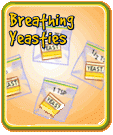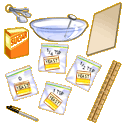

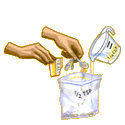

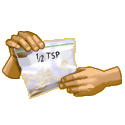

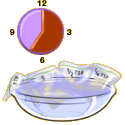

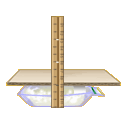

Experiment Category:
Objective:
What You Need:
- Four (4) quart-sized Ziploc bags
- 4 packets of activated dry yeast
- sugar
- 1 teaspoon
- 1 measuring cup
- about 6 cups warm water (about 46oC or 115oF)
- large bowl
- marking pen (permanent ink)
- thermometer
- piece of cardboard (or notebook with a stiff back)
- ruler
- pen or pencil
To Do and Observe:
1. Pour one packet of activated dry yeast into each Ziploc bag.
2. Add 1 teaspoon of sugar to one of the bags and label the bag 1 tsp.
3. Add ½ teaspoon of sugar to another bag and label it as ½ tsp.
4. Add ¼ teaspoon of sugar to the fourth bag and label it as ¼ tsp.
5. Mark 0 on the outside of the last bag and do not add any sugar to it
6. Pour warm water into the large bowl so it is about 2/3 full. Check the temperature of the water with the thermometer. The water should be about 46oC (115oF). Add hot or cold water to bring the water to this temperature.
7. Use the measuring cup to dip ¼ cup of warm water from the bowl into each of the bags. Gently squeeze each bag between your fingers to mix the contents thoroughly. Make sure that there are no dry pockets of yeast or sugar in the bags.
8. Squeeze most of the air out of the bags and seal them. Set the bags in the bowl of warm water in a warm place so it will not cool down rapidly.
9. Wait 30 - 40 minutes.
10. Take the bag marked 0 out of the water, dry it, and place it on a flat table. Put the cardboard or notebook on top of the bag, holding the tablet level. Use the ruler to measure the distance from the table to the bottom of the cardboard.
11. Record your measurements.
12. Repeat #10 with the remaining bags.
13. Calculate the approximate volume of carbon dioxide in each bag: measure the length of the bag (a); measure the width of the bag (b); distance from table to cardboard (c). a x b x c will give you the volume in each bag.
What's Going On:
Many scientists are interested in the effects of natural recycling that takes place in the Earth's biosphere. Recycling biodegradable material often requires the presence of moisture for the microorganisms (creatures responsible for the biological breakdown of trash) to be activated.
The yeast in this experiment consists of living organisms that break down (decompose) the substrate (sugar and water) and produce carbon dioxide gas. Although its hard to see a microorganisms without a microscope, you can see evidence (the carbon dioxide) of them "eating", which is how they break down food sources (in this case sugar) that provide energy for their tiny systems and help recycle materials. The bags contain various amounts of carbon dioxide because more decomposition took place in the bags with larger amounts of sugar; the yeast in the bag marked 0 had no sugar to "eat", so no carbon dioxide was produced.
Scientists are also interested in microorganisms in outer space - does life exist out there? One example is the search for life on Mars. Life forms aren't readily visible on the surface, but scientists look for other kinds of evidence that microorganisms might exist. What kinds of experiments could be designed to identify life? Could this experiment (or part of it) apply?
Parent/Teacher Tips:
Be careful when handling hot water and the thermometer - if the water is too hot, you'll kill the yeast!
Ask your children how the yeast used in this experiment might be connected to the life cycles, the water cycles and the carbon cycles in the Earth's biosphere. Encourage them to do a little research and find out!

